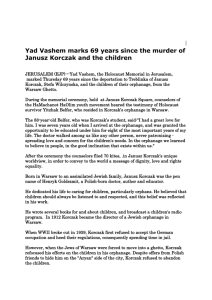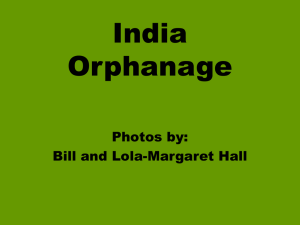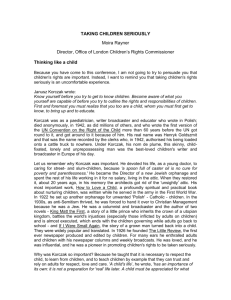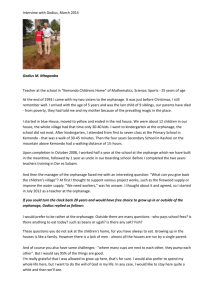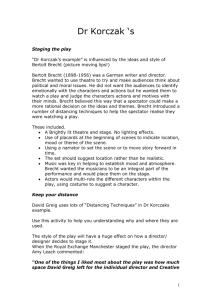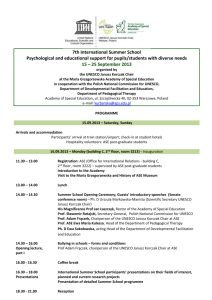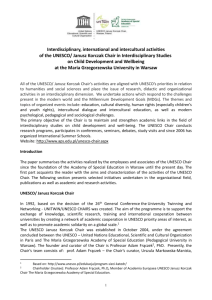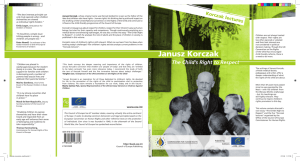Janusz Korczak
advertisement
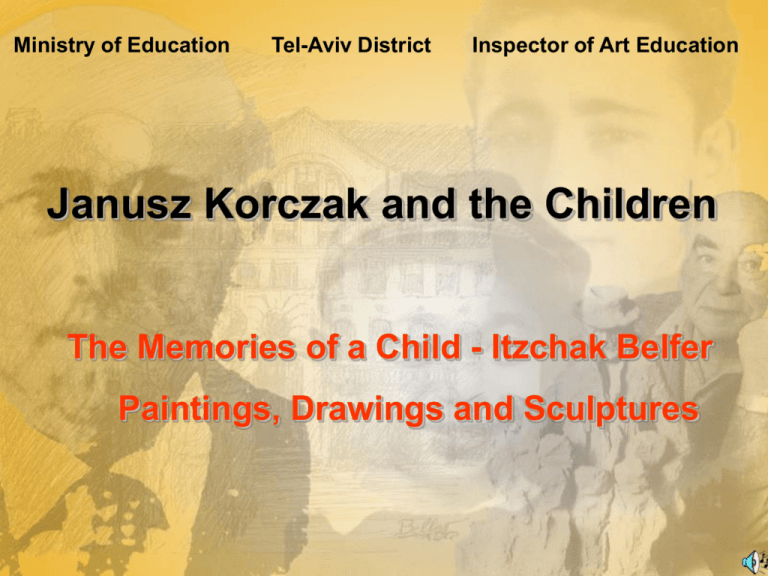
Ministry of Education Tel-Aviv District Inspector of Art Education Janusz Korczak and the Children The Memories of a Child - Itzchak Belfer Paintings, Drawings and Sculptures Ministry of Education Tel-Aviv District Inspector of Art Education Janusz Korczak's educational philosophy, built on the foundations of humanistic values, is relevant and current in many areas that interest children and educators. Terminology and principles such as: “children’s society ", "children's right to respect“ and awareness of pupils’ differential needs, are a few examples of his pedagogical philosophy and are inspirational sources for implementation of current views on education of values. It is our obligation as educators to continue teaching according to Korczak's principles and values. Itzchak Belfer, the artist, was educated at Korczak's orphanage for eight years. In his artwork, which is shown in this presentation, he reflects the image of the educator he so loved and admired. This is a unique form of witnessing which allows the audience a powerful description of the extraordinary experience of that period in history We will remember and never forget the great educator- Janusz Korczak and his children. Sara Cohen Bonen , Michal Eshel THE VOW ABRAHAM SHLONSKY By the eyes that witnessed bereavement and burdened my bowed heart with cries, By the compassion that taught me forgiveness Until days came that prohibited pardon, I contracted the vow to remember all, To remember -- and nothing forget. TRANSLATED BY KAREN ALKALAY-GUT Janusz Korczak Dr. Henryk Hirsh Goldszmit- The rare combination of an author, pediatrician, educator and philosopher brought to the world an innovative educational philosophy. “A hundred children, a hundred individuals who are people--not people-to-be, not people of tomorrow, but people of now, right now—today.” Janusz Korczak Janush Korczak and the Children, drawing 25/35 cm, 1990 Itzchak Belfer, The Artist "I lived with him for eight years and have been enlightened by him my entire life.“ Itzchak Belfer was a child at Korczak's orphanage. His paintings and drawings, shown in this presentation, describe Korczak and the children during the periods before World War II and during the Holocaust (1939-1945). Belfer lost his father in 1927. His mother, who had five other children, brought him to the orphanage at the age of seven. He was educated there until the age of fourteen. After that, he was given permission to stay until the age of fifteen. In the spring of 1940, a year after the occupation of Warsaw, Belfer received Korczak's blessing and a small amount of money to run away from the city to the forest at the Russian border. After the war, he returned to Poland and he discovered the tragic dimensions of the Holocaust. He tried to immigrate to Israel in 1947 on the famous ship, "Af Al Pi Chen" which was seized with all its passengers and rerouted to Cyprus. In Cyprus, he began to paint and learned sculpture with the sculptor and teacher, Dov Ben-Tzvi. He was finally able to immigrate to Israel in 1949. Belfer's entire family perished in the Holocaust. Janusz Korczak Henryk Hirsch Goldszmit 1878-1942 Janusz Korczak, Oil on Canvas, 60/45 cm, 2002 "It is not enough to love children. You need to understand them and treat them as human beings. Give them the same rules, rights and obligations that adults must abide by. "How much, do we as adults, need to educate ourselves in order to understand children?“ Janucz Korczak Korczak Among the Children, Water Color on Paper, 100/70 cm., 2000 Korczak the Philosopher, Watercolor on Paper, 90/70 cm, 2004 Korczak, Bronze Sculpture, 60 cm Bronze sculpturee, 220 cm, In front of the Girls' Gymnasia, Ginzburg, Germany "Adults live in the outer realm of children's lives as children live in the outer realm of adults' lives. When will the joyful time come that children and adults will exist in parallel paths?“ Janusz Korczak Korczak in a Conversation with the Children, Black Marker, 35\25 cm Janusz Korczak and the Children In 1908, 80 orphans lived in the Jewish community of Warsaw. The community looked for volunteers to educate these children. The first person to volunteer was Stefania Wilczynska. Immediately after her, Janusz Korczak, a young pediatrician and author who was interested in education and the world of children joined the orphanage. In 1912, Korczak became the director of the new orphanage which was built according to his plans. There were 56 girls and 51 boys in the orphanage. There was a large hall that was used as a dining room, a party area and game room. In addition to two large dormitories, there were "quiet corners" for studying, craft and sewing workshops, etc. Korczak's pedagogical approach was based on love and respect for children. The children governed their lives and decided on the Stefania Wilczynska, Administrative director and senior educator Stefa was always there. She was a strong and comforting woman. Her deep feelings and warm personality brought about confidence and respect among the children and young counselors. Stefa and the Children, Black Print Color on Paper, 70/100 cm Janusz Korzcak implemented his educational philosophy at his orphanage. With Stefa's help, the orphanage was selfgoverned by the children. The children's governing council was responsible for the daily routine of life, such as chores. The Orphanage at 92 Krochamelna Street, Warsaw, Poland, 1912 A court of peers in which children were judges was implemented in the orphanage. The same constitution governed all residents (including staff). In section 6c of the constitution, it is written: "The children must obey the obligatory rules and not the staff. The staff must know the rules and act accordingly. In order to receive special privileges, one needs to make a request to the independent children's governing council. The governing council is allowed to deny staff requests." The front of the Orphanage. Black marker on paper, 35/25 cm, 1975. During World War I, Korzcak served as a doctor in the Russian Army. During that period, he wrote his book, "How to Love a Child". Later, he wrote "The Right of a Child to Respect". Korczak Speaking with Children, Sketch, 35/25 cm Korczak Pediatrician, Black Marker, 70/50 cm In 1918, Korczak returned to head the orphanage which had been run by Stefa. During his absence, the orphanage functioned according to his philosophy: "Only through education can the world become a better place." In 1939, at the beginning of World War II, The orphanage continued its regular activities and studies. At the end of 1940, the Germans transferred all the residents of the orphanage to the Warsaw ghetto. In the ghetto, the conditions were bad, it was very crowded and food was scarce. The number of children increased to 200. There were still "quiet corners", doll corners and various activities. The children felt at home, organized plays and continued their routine. The Deportation from the Orphanage to the Ghetto, Acrylics on paper, 100/70 cm, 1970. The Exile to the Ghetto, Dry brush on paper, 50/70 cm, 1958 Children in the Ghetto, Black Print Color on paper, 50/70 cm, 1981 Detail The Exile to the Ghetto, Dry brush on paper, 50/70 cm 1958 Korczak Looks for Food in the Ghetto, Pencil. 35/25 cm, 1990 Korczak Collects Children in the Ghetto, Pencil, 35/25 cm, 1990 The situation in the ghetto worsens: Hunger, Disease, Death Korczak and the Children before the Deportation, Acrylics, 100/70 cm 1983 Stefa and the Children before the Deportation, Acrylics, 100/70 cm, 1983 Mother and Child, Acrylics, 100/70 cm, 1997 Korczak with the Children in the Ghetto, Drawing , The middle part of Tripatichon, 100/70 cm Warsaw Ghetto fighters, Dry Brush using Black Print Color, 100/70 The Death March, Oil on Canvas, 160/120 cm, 1963 The Kaltza Riots, in 1946, Oil on Canvas, 100/70 cm, 1963 Stefa, Black Print Color, 50/35 cm, 1975 During the final days in the ghetto, Stefa prepared everything for the journey. She had no illusions. She dressed the children in their best clothes. They numbered 192 children and 8 adults, in addition to Korczak and Stefa. Stefa Protects the Children, Black Print Color, 50/35 cm, 1976 The deportation to Treblinka Extermination Camp occurred on August 5, 1942. SS men and Ukrainians lined the streets. At eight o'clock in the morning, two sharp whistles and screams of : " All Jews Outside!" were the signs that the deportation had begun. The children came down obediently and organized themselves in groups of five. Stefa and Korczak came down with them. The Beginning of the March to the Cattle Cars, Sketch on Ripidograph, 50/35 cm, 1986. A Discussion before The Deportation, Pencil, 50/35 cm, 1986 Going into the Cattle Cars, Sketch on Ripidograph, 50/35 cm,1990 The children, led by Korczak, marched in the streets of Warsaw on their way to Treblinka Extermination Camp, Stefa marched at the end of the group of children. " They were the first taken to die, the first in the wagon. They were flung into the big wagons like heaps of dung And were carried off, killed, exterminated, Not a trace remained of my precious ones! Woe unto me, woe.” From the poem “ The Song of the Murdered Jewish People” by Iitzchak Katzenelson, translated by N.H. Roseblum AND NEVER AGAIN! The End, Sketch on Ripidograph ,35/25 cm, 1986 In Israel, after the Sinai War, Itzchak Belfer completed four years of studies at Avni Institute and two additional years studying the history of art. In 1965, Belfer became a member of the Painters and Sculptors Society of Israel. In 1972, he became a teacher at The Community College in Tel Aviv and became the director of drawing and sketching courses for the Tel Aviv Municipality. The Artist in his Studio “With each attempt to put on paper or canvas or to find ways to express the horrors of the Holocaust, I felt doubtful - Is it possible? Can an artist express the horror and fear, the inhuman and incomprehensible reality of persecution and total hatred of that time?” Itzchak Belfer יצחק בלפר “Any way of expressing memories of the Holocaust is positive and worthwhile. Just don’t let apathy and forgetfulness overcome us." Itzchak Belfer Janush Korczak and the Children Concept, writing and editing: Michal Eshel Sarah Cohen- Bonen Yitzchak Belfer English Translation: Marsha Hachmon Music: Elad Cohen- Bonen
